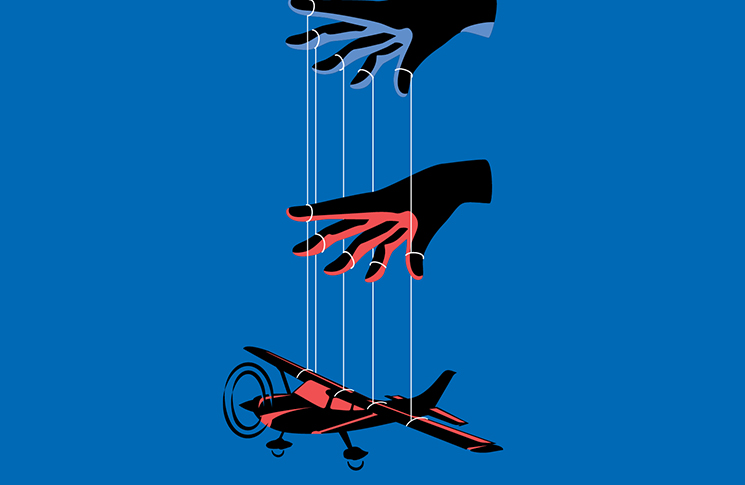Almost too late, a young pilot learns the importance of assertiveness as part of flight control.
The morning dawned cold and grey, the sort of morning that fails to lift your spirits – and you seek something to brighten your day.
In a distant office a phone rang, and I strained to hear whether this was a job or not. It wasn’t long before my boss appeared with news that I was to wing my way west to an isolated property in northern NSW. I was to pick up a respected middle-aged property owner and his wife and fly them to the Hunter Valley.
My employment with this charter company had begun 6 months earlier. The organisation has Cessna 182s and, as a new commercial pilot, I was learning rapidly how little I knew about flying.
My heart sank as I looked out and noted the signs of a south-east stream weather system affecting the upper reaches of the Hunter Valley.
Tentacles of cloud were already clawing their way down the gullies of the western side of the Great Dividing Range. This meant the Hunter Valley would be, to use the curious phrase for IMC, socked in, and difficulty could be expected in reaching Scone VFR.
My boss had also noted the conditions and suggested that if I couldn’t make it to Scone, there was an agricultural strip near Murrurundi at the head of the valley. Perhaps I could land and arrange a taxi to transport my passengers to Scone.
I duly arrived, met my passengers, and departed.
About an hour later as we approached the ranges which form the western edge of the Hunter Valley, the view out front became more depressing. Clouds clung protectively to the tops of the hills and spread downwards like a gigantic tablecloth.
Clearly the valley around Scone wouldn’t be VFR, so I altered course for ‘the gap’. This was a low saddle in the hills at the head of the Hunter Valley near the town of Murrurundi.
If the valley was socked in, one could sometimes squeeze through the gap into the valley, which could then be followed – as if flying in a tube – southwards towards Scone about 30 miles away.
By now my male passenger had become increasingly interested in the progress of the flight and chose to vehemently assure his inexperienced ‘wet behind the ears’ 23-year-old pilot, that all was well. He would ‘show me the way’ to Scone from here and we would easily negotiate the gap.
As we approached this well-known piece of terrain, I was filled with anxiety, as drizzle seriously reduced visibility and swirling cloud threatened to engulf us.
If I had been left to my own decision-making, I would have turned back then but my male passenger continued with his patter. ‘Just down here, son’ and ‘when we get through the gap, turn hard left and follow the road.’ And, ‘It’s all right, I can see out my side.’
Every emotion in my body was screaming, ‘Don’t let this man take over the aircraft, this is crazy!’ But I had failed to stand up to this passenger and assure him I was in command. And clearly, I wasn’t, as we had already scurried through the gap at a dangerously low altitude – well beyond my better judgment.
He continued his instructions: ‘Hard left over the town and just follow the road.’ ‘It’s okay, stay in the middle of the valley, the road turns right just up ahead.’
‘Just up ahead’ could hardly be seen in the drizzle, as we barrelled along, 250 feet above ground at 90 knots with 10 degrees of flap.
I snapped a look at the fog and drizzle-shrouded hills on either side of us and cursed myself for not remaining in command of the aircraft.
I looked at the western side of the valley and with a pounding heart, judged that if we suddenly entered cloud, I would just have enough room to pull a 180-degree turn, as long as the bank was steep.
I didn’t have long to wait. Suddenly, a patch of stratus flashed beneath us! Then instantly, we were in cloud at 200 feet!
Ignoring the instruction, ‘Go lower, go lower, straight down here now’ coming from the specialist beside me, I flung the old 182 into one of the steepest and well-balanced turns I had ever made! With my eyes glued to the artificial horizon, I clung to the yoke and hoped and prayed we would complete the turn before we found the side of the valley.
Suddenly, a patch of stratus flashed beneath us! Then instantly, we were in cloud at 200 feet!
‘What are you doing?’ came the retort from my self-appointed copilot and navigation consultant, followed by a ‘look out!’
I snapped my eyes from the instruments to the view outside. The windscreen was filled with terrain – dirty brown terrain featuring glistening shrubs, small jutting rock faces and rivulets of water flowing down a hillside.
Shock smashed my already rigid body. I yanked back on the control wheel like a man possessed, resulting in a resounding ‘crack’ somewhere towards the rear of the fuselage.
My prayer was answered. We cleared the menacing hillside – by how much I will never know, but we were alive and heading back up the valley.
My ‘copilot’ immediately accused me of getting him lost and firmly informed me he could see no reason why we couldn’t continue on down to Scone. His wife in the back seat leaned forward and expressed a similar view.
However, my lesson was learnt, indeed taught, by bitter experience. I was reassuming the command of the aircraft, which I had so foolishly relinquished.
I headed back north towards Murrurundi and, in a rather arrogant and robust fashion, assured my passenger what we would be doing next and why.
As the protests gradually diminished, I located the ag strip on the edge of town, landed and followed the plan that my boss had suggested hours before.
Lessons learnt
Make sure you:
- never allow yourself as pilot in command to have the flight manipulated by a passenger
- review weather conditions for your route, departure and destination aerodromes as well as alternates
- know your minimum safe altitude for the route
- monitor the weather conditions throughout the flight
- avoid IMC before you enter it. Consider conducting a 180-degree turn
- change to instruments and start a scan of them if you inadvertently enter IMC – trust your instruments and avoid large control inputs
- consider your options and DECIDE once the aircraft is under control – decision making model: DODAR: diagnose, consider options, decide, act, re-assess
- notify ATC of your diversion if you have submitted a flight plan. Ask ATC for assistance if you require it.
Weather and forecasting
Weather and forecasting is one of the special topics on our Pilot safety hub. Refresh your knowledge.
Online extra
Don’t forget to check out the audio close calls. Hear the stories come to life.
Have you had a close call?
8 in 10 pilots say they learn best from other pilots and your narrow escape can be a valuable lesson. We invite you to share your close call experience to help us improve aviation safety, whatever your role.
Disclaimer
Close calls are contributed by readers like you. They are someone’s account of a real-life experience. We publish close calls so others can learn positive lessons from their stories, and to stimulate discussion. We do our best to verify the information but cannot guarantee it is free of mistakes or errors.






Comments are closed.